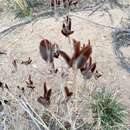Comprehensive Description
provided by North American Flora
Earleocassia durangensis (Rose) Britton
Cassia durangensis Rose, Contr. U. S. Nat. Herb. 10: 98. 1906.
Herbaceous, the stems often branched above, 2-4 dm. high, densely velvety-pubescent and sometimes long-pilose. Stipules linear, persistent; leaflets 1 pair, broadly oblong to suborbicular, 3-5 cm. long, densely soft-pubescent on both sides; gland slender; peduncles longer than the leaves, 1-5-flowered; sepals densely pilose, about 7 mm. long; petals 12-15 mm. long; legume compressed, 3-3.5 cm. long, about 7 mm. wide, densely pubescent, straight, tipped by a slender terminal, at length deciduous style.
Type locality: Near city of Durango, Durango. Distribution: Southern Texas to Durango.
- bibliographic citation
- Nathaniel Lord Britton and Joseph Nelson Rose. 1928. (ROSALES); MIMOSACEAE. North American flora. vol 23(1). New York Botanical Garden, New York, NY
Physical Description
provided by USDA PLANTS text
Perennial, Shrubs, Herbs, Stems woody below, or from woody crown or caudex, Stems erect or ascending, Stems less than 1 m tall, Stems solid, Stems or young twigs sparsely to densely hairy, Stem hairs hispid to villous, Stems silvery, canescent, tomentose, cobwebby, or wooly, Leaves alternate, Leaves petiolate, Extrafloral nectary glands on petiole, Stipules inconspicuous, absent, or caducous, Stipules setiform, subulate or acicular, Stipules persistent, Stipules deciduous, Stipules free, Leaves compound, Leaves even pinnate, Leaf or leaflet margins entire, Leaflets opposite, Leaflets 2, Leaves hairy on one or both surfaces, Flowers in axillary clusters or few-floweredracemes, 2-6 flowers, Inflorescences racemes, Inflorescence axillary, Bracts very small, absent or caducous , Flowers actinomorphic or somewhat irregular, Calyx 5-lobed, Calyx hairy, Petals separate, Petals orange or yellow, Stamens 9-10, Fertile stamens 6-8, Stamens heteromorphic, graded in size, Stamens completely free, separate, Filaments glabrous, Anthers opening by basal or terminal pores or slits, Style terete, Fruit a legume, Fruit stipitate, Fruit unilocular, Fruit freely dehiscent, Fruit elongate, straight, Fruit oblong or ellipsoidal, Fruit exserted from calyx, Fruit compressed between seeds, Fruit hairy, Fruit 3-10 seeded, Fruit 11-many seeded, Seed with elliptical line or depression, pleurogram, Seeds ovoid to rounded in outline, Seed surface smooth, Seeds olive, brown, or black.

